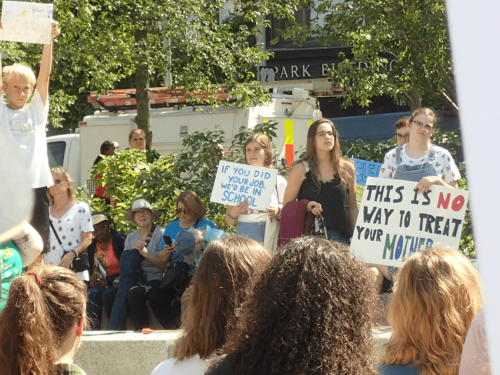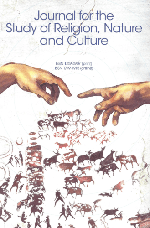Sarah Pike on Climate Strikes as Eco Rituals

Students gathered at the 2019 Youth Climate Strike held in Cleveland, Ohio. (Image credit: chris crews)
We’re excited to highlight a recent article by Professor Sarah Pike on the Youth Climate Strikes entitled ‘Climate Strikes as Rituals to Save the Earth‘. Building on her earlier work around environmenal activism and ritual, Dr. Pike asks what it could mean to think about these latest youth climate strikes as a form of ritual action to save the Earth. Here are a few highlights from her piece:
How might climate strikes function as rituals to save the earth? In a 2003 article “Ritual Theory and the Environment,” ritual theorist Ronald Grimes described some ways in which people were turning to rites such as tree ordination, symbolic walks re-enacting the story of evolution, and ritualizing prairie burnings for restoring ecosystems as “effective means of saving the planet from environmental destruction.” Climate strikes differ in that they are global, rather than local, are coordinated to happen simultaneously, and are widely covered by the news media and social media networks. Yet young climate strikers, through ritualized protest activities such as walking out of school, similarly draw on the potential efficacy of ritual. Their bodies acting together in the streets are engaged in ritualized activities that make the streets and public squares into sacred spaces that embody what the protesters most cherish, their ultimate values: the integrity of the planet, the rights of all people to a future. And they seem to be having some impact.
Although protests concerning climate change have been happening for years, recent climate strikes have brought young people forward as actors on the world political stage in unprecedented ways, with high school students leading the way. These students claim public space in ritualized ways, orchestrating their movements, chanting together, and carrying symbolic objects such as posters with slogans. Their bodies, acting together, bring the vision of a different future into public awareness, by seizing spaces (such as Westminster, the heart of government power in London) identified with empire, progress, the ways things have been done by industrialized nations and corporate powers. Climate strikers reject what these spaces of power stand for and demand a future that enables the flourishing of humans and the rest of the living world…
In my book For the Wild: Ritual and Commitment in Radical Eco-Activism (2017), I describe the ways in which activists’ vulnerable bodies in protest actions such as tree-sits and road blockades bring into public view other beings. In climate strikes too, activists’ rebellious and vulnerable bodies turn streets that would channel cars burning fossil fuels through cities into sites of resistance, making visible the unseen climate costs of our lifestyles. These protests are interventions, ruptures in the social order. Performance theorist Tony Perucci calls protests “ruptural performances” because “they disrupt the experience of daily life, a rupture of the living of social relations….” Climate activists make visible the disruptions of climate change, other forms of life on earth that are being effected, Indigenous communities, and poor communities that are disproportionately bearing the brunt of climate change. These often invisible “others” are brought into public view when activists’ bodies assemble in the streets, referencing the lives of suffering others.
Climate strikers insist that the world can be otherwise, that there is a better way. It is these alternate ways of thinking and being in the world that give protests their distinctive qualities. Strikers participate in and orchestrate performances meant to skew assumptions about what and who is of value.
You can read the full story over at CounterPoint.












